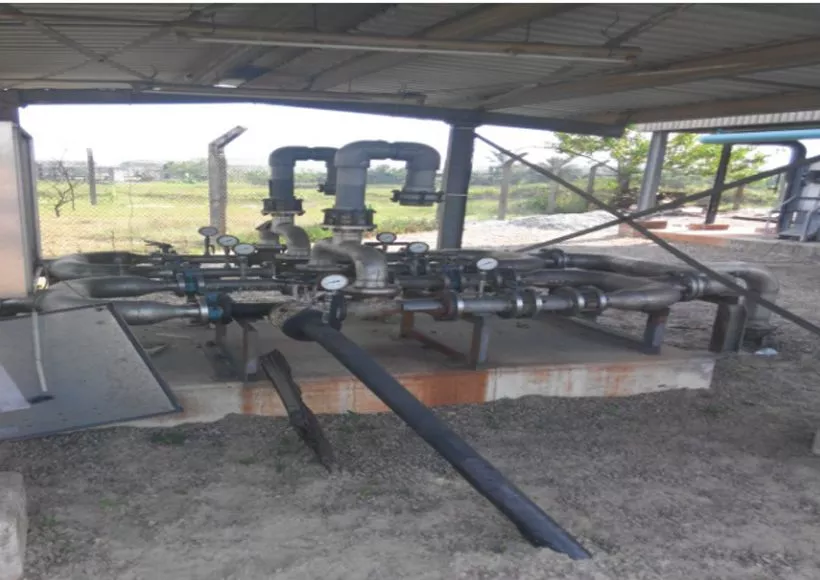Generally, Water treatment can be defined as a system/process of removing foreign/alien chemicals, biological contaminants, suspended solids, and gases from contaminated water. Above all the objective of the water treatment process of this process is to produce water fit for a specific purpose.
Most water is disinfected for human consumption (drinking water). However water treatment may also be designed for a variety of other purposes.
Generally, this includes making water quality meets the requirements of medical, pharmacological, chemical, and industrial applications.
In general, the methods used include physical processes such as filtration, sedimentation, and distillation. Biological processes such as slow sand filters or biologically active carbon.
However chemical processes such as flocculation and chlorination and the use of electromagnetic radiation such as ultraviolet light.
FUNCTION OF THE COMPONENT PORTABLE WATER TREATMENT PLANT
Generally, there are several important components and chemicals used in most water treatment plants. In addition, the water treatment plant is commonly used in the industries and even by small scale water production company/factory that produces sachet water commonly called “Pure water” by Nigerians.
Above all, source of water is mostly from borehole, stream, river, or dam. Various components/chemicals include the following:
- Borehole: Generally, a borehole is a narrow shaft bored in the ground for the extraction of water.
- Aeration Unit: Aeration Unit circulates, mix or dissolve air in the water to increase the oxygen content of water. In addition to dispel dissolved gases such as carbon dioxide or chloride and to oxidize suspended compound in the water.
- Calcium hypochlorite (Ca(OCl)2): Generally, Calcium hypochlorite (Ca(OCl)2) is used for disinfecting the water therefore killing the bacteria present.
- Caustic Soda (NaOH): Generally, Caustic Soda (NaOH) is used to regulate the pH level of the water.
- Reservoir: Above all reservoir is used to stores the pre-treated water.
- Utility water pump: Generally, Utility water pump facilitates the pumping of water to the utility tank.
- Portable water pump: Generally, portable water pump is used to pump water from the reservoir to the portable water treatment unit.
- Polyelectrolyte: For instance, an example of Polyelectrolyte is Polydiallyldimethylammonium (PDADMA), which is used to destabilize the colloidal suspension and to initiate flocculation.

- Sand filter: Sand filter consist of activating charcoal therefore removes pathogens, taste, and odor from the water.
- Polishing filter: Polishing filter removes small usually microscopic particulate material and above all removes a very low concentration of dissolved material from the water.
- UV sterilizer: In addition, UV sterilizer utilizes ultraviolet (UV) light to kill microorganisms.
PORTABLE WATER STANDARD
Generally, portable water quality standards also referred to as drinking water quality standards indicate the quality parameters set for drinking water.
In addition countries like United States, China, Germany, Italy, United Kingdom, etc specify standards to be applied in their own country.
However, in Europe, this includes the European Drinking Water Directive and in the USA the United States Environmental Protection Agency (EPA) set specific standards as required by the Safe Drinking Water Act.
However, for developing countries that don’t have organizations for such standards, the World Health Organisation publishes guidelines on the standards.
World Health Organisation Guidelines
Generally, the World Health Organisation (WHO) establishes the following specification limits on naturally occurring constituents that may have direct adverse health impact:
- Arsenic 10μg/l
- After that, Barium 10μg/l
- Boron 2400μg/l
- After that, Chromium 50μg/l
- Fluoride 1500μg/l
- Selenium 40μg/l
- In conclusion, Uranium 30μg/l
In addition, the potential occurrence in drinking water of artificial in other words synthetic pollutants generated by human activities. Therefore the following standards have been proposed:
- Cadmium 3μg/l
- Mercury 6μg/l
Generally, Organic species:
- Benzene 10μg/l,
- Carbon tetrachloride 4μg/l
- 1,2-Dichlorobenzene 1000μg/l
- 1,4-Dichlorobenzene 300μg/l
- Dichloromethane 20μg/l
- Di(2-Ethylhexyl)phthalate 8μg/l
- 1,4-Dioxane 50μg/l
- After that, Edetic acid 600μg/l
- Ethylbenzene 300 μg/l
- After that, Hexachlorobutadiene 0.6 μg/l
- Nitrilotriacetic acid 200μg/l
- After that, 1,2-Dichloroethane 30μg/l
- Tetrachloroethene 40μg/l
- After that, Toluene 700μg/l
- Trichloroethene 20μg/l
- Xylenes 500μg/l
- In conclusion, 1,2-Dichloroethene 50μg/l
In addition other parameters are:
| S/N | PARAMETERS | W.H.O STANDARD |
| 1 | pH | 6.5-8.5 |
| 2 | COLOUR | 15 TCU |
| 3 | SALINITY | 0.0% |
| 4 | T.D.S | 500Mg/l |
| 5 | CONDUCTIVITY | 100us/cm |
| 6 | FREE CHLORINE | 0.2Mg/l |
| 7 | TOTAL CHLORINE | 1.0 Mg/l |
| 8 | IRON | <0.03Mg/l |
| 9 | TOTAL HARDNESS (Ca) | 150Mg/l |
| 10 | TOTAL HARDNESS (Mg) | 150Mg/l |
